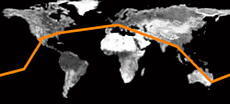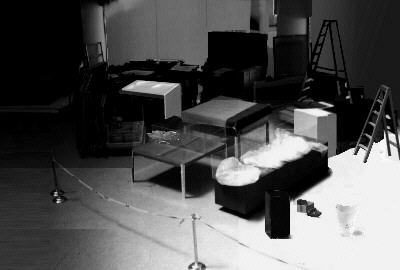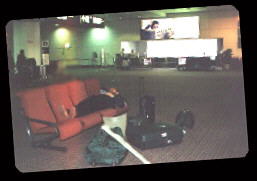"Museophagia, the name says it
all, means the tendency or habit of eating museums. It is something that the Internet is beginning to do right
now, or at least it is taking nibbles. The first evidence of museophagia, in fact a kind of digital bulimia, was the attempt of Bill
Gates, through a company called Corbys, to gobble up by fact of digitization and scanning all the contents of museums and galleries that Corbys deemed
fit, to regurgitate them on line, at a cost, of course, via proprietary
channels.
Museophagia, the website and the subject of this book, is more modest in its intentions than those of Bill
Gates, it merely purports to consume via digitization objects (furniture, fixtures
etc.) that Maurizio Bolognini took from art galleries of various cities, during a world tour starting from the Cavellini Foundation
Gallery. Fair game..."
(Derrick de Kerckhove, "Museophagia - The art gallery in the age of its digital
reproduction", in Raptus, Nuovi Strumenti, 1999)
"Out-of-date commodities have to be recycled. Which better re-use than the creation of a travelling room of
wonder, like that proposed by Bolognini, who has returned from pilgrimages to exotic
lands, full of objects standardized by the global economy:
fire-extinguishers, chairs, note-pads... We are waiting, full of
expectation, for an event that perhaps could be defined as the breaking of the icon, that could lead us to confront painfully the perception of the negated
objects, that only the intention of the artist can remove from their everyday
'con-fusion'".
(Paola Sega Serra Zanetti, "Phenomenology of an aesthetic-artistic
event", in Raptus, Nuovi Strumenti, 1999)
|
"Museophagia, lo dice il nome, significa tendenza o abitudine a consumare i musei. ╚ qualcosa che Internet sta cominciando a fare proprio ora, o almeno si appresta ad assaggiarne alcuni bocconcini. La prima prova di
museofagia, in effetti una specie di bulimia digitale, Ŕ stato il tentativo di Bill
Gates, attraverso una societÓ chiamata Corbys, di inghiottire, con la scansione e la
digitalizzazione, tutto il contenuto dei musei e delle gallerie ritenuti adatti, per poi restituirlo in linea, a pagamento naturalmente, su reti private.
Il progetto Museophagia, il website e l'argomento di questo libro, hanno ambizioni pi¨ modeste di quelle di Bill
Gates. Essi pretendono di consumare, attraverso la digitalizzazione, soltanto gli oggetti (arredi, infissi ecc.) prelevati da Maurizio Bolognini in gallerie d'arte di diverse cittÓ, che egli ha raggiunto compiendo un giro del mondo, iniziato dalla galleria della Fondazione
Cavellini. Gioco corretto..."
(Derrick de Kerckhove, "Museophagia
- La galleria d'arte nell'epoca della sua riproducibilitÓ digitale", in Raptus, Nuovi Strumenti, 1999)
"Le merci inattuali vanno riciclate. Quale migliore ri-utilizzo che la creazione di una
camera delle meraviglie itinerante come quella che ci propone Bolognini, reduce da pellegrinaggi in terre esotiche, ricco di oggetti omologati dal commercio globale: estintori, sedie, block-notes... Siamo in trepida e meravigliata attesa dell’evento, che forse potremmo definire di sfondamento dell’icona, che ci fa dolorosamente affrontare la percezione degli oggetti negati, che solo l’intenzionalitÓ dell’artista strappa alla quotidiana
'con-fusione'."
(Paola Sega Serra Zanetti, "Fenomenologia di un evento
estetico-artistico", in Raptus, Nuovi Strumenti, 1999)
|




